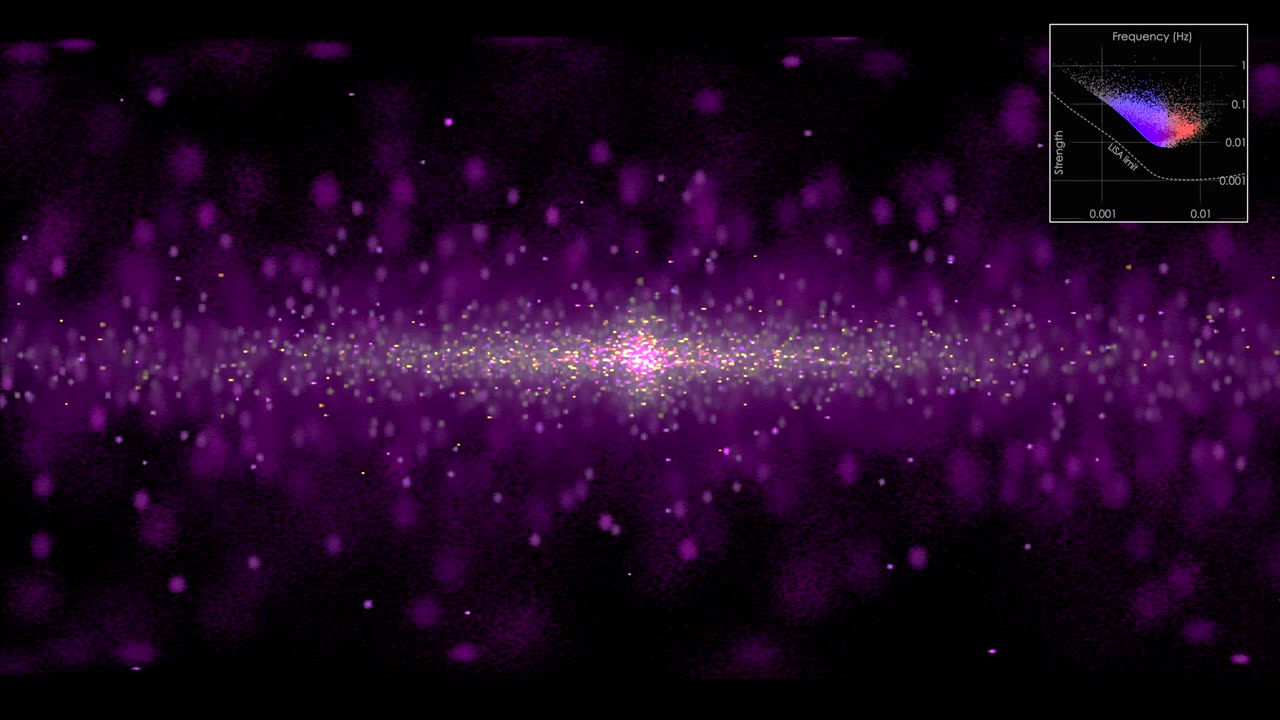Premium Only Content

Synthetic Gravitational Sky
Watch as gravitational waves from a simulated population of compact binary systems combine into a synthetic map of the entire sky. Such systems contain white dwarfs, neutron stars, or black holes in tight orbits. Maps like this using real data will be possible once space-based gravitational wave observatories become active in the next decade. Brighter spots indicate sources with stronger signals and lighter colors indicate those with higher frequencies. Larger colored patches show sources whose positions are less well known. The inset shows the frequency and strength of the gravitational signal, as well as the sensitivity limit for LISA (Laser Interferometer Space Antenna), an observatory now being designed by ESA (European Space Agency) in collaboration with NASA for launch in the 2030s.
Music credit: "Shadowless" from Universal Production Music
Credit: NASA's Goddard Space Flight Center
Producer: Scott Wiessinger (KBR Wyle Services, LLC)
Science writer: Francis Reddy (University of Maryland College Park)
Visualizer: James Ira Thorpe (NASA/GSFC)
This video can be freely shared and downloaded at https://svs.gsfc.nasa.gov/14402. While the video in its entirety can be shared without permission, the music and some individual imagery may have been obtained through permission and may not be excised or remixed in other products. Specific details on such imagery may be found here: h/14402. For more information on NASA’s media guidelines, visit https://NASAvedio knowledge/multimedia
-
 3:14:33
3:14:33
Joe Donuts Gaming
9 hours ago🟢 Live : Christmas is Here!! | Fortnite, Caroling, Light Tours and Donos !!
38.8K11 -
 6:02:38
6:02:38
CLUJ
9 hours agoCHRISTMAS EVENING HYPE!! LETS HAVE FUN GAMING!!
36.6K6 -
![I AM FINALLY BACK :: PUBG: BATTLEGROUNDS :: RUMBLE NOW HAS GIFTED SUBS!!! [Merry Christmas] {18+}](https://1a-1791.com/video/fwe1/22/s8/1/e/f/C/6/efC6v.0kob-small-I-AM-FINALLY-BACK-PUBG-BATT.jpg) 9:57:19
9:57:19
a12cat34dog
11 hours agoI AM FINALLY BACK :: PUBG: BATTLEGROUNDS :: RUMBLE NOW HAS GIFTED SUBS!!! [Merry Christmas] {18+}
26K4 -
 3:55:42
3:55:42
STARM1X16
10 hours agoMerry Christmas Fortnite
73.5K8 -
 2:45:33
2:45:33
Sgtfinesse
10 hours agoMerry Christmas Night
61.1K18 -
 3:51:18
3:51:18
tacetmort3m
1 day ago🔴 LIVE - (MERRY CHRISTMAS) TIME TO SPREAD DEMOCRACY - HELLDIVERS 2 OMENS OF TYRANNY
34.4K2 -
 2:46
2:46
BIG NEM
13 hours agoDiscovering RAKIJA: The Holy Liquer of the Balkans
23.5K2 -
 1:11:38
1:11:38
Film Threat
18 hours agoCHRISTMAS DAY CHILL STREAM WITH CHRIS GORE | Hollywood on the Rocks
143K31 -
 14:22:40
14:22:40
The Quartering
1 day agoYule Log Christmas MAGA Edition With Memes! Come Hang Out!
232K29 -
 38:41
38:41
MYLUNCHBREAK CHANNEL PAGE
1 day agoTimeline Begins in 1800? - Pt 1 & 2
111K66